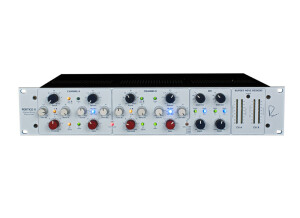Fiche technique
- Fabricant : Rupert Neve Designs
- Modèle : 535
- Catégorie : Compresseurs de studio
- Poids du colis : 933 g
Threshold
A 31-position detented pot that sets the level at which compression begins, from -25dB to +20dB. Turning this control counter-clockwise will increase the amount of compression; turning it clockwise will decrease the amount of compression.
Ratio
The RATIO control has six selectable positions on a rotary switch, allowing the user to set the slope of the compressor curve with pre-selected ratios of 1.5:1 through 8:1 for levels above the determined THRESHOLD. This range of compression ratios allows the user to compress as moderately or heavily as desired.
Timing
The TIMING control is a six-position rotary switch that sets the compressor attack and release times. The timing can be further modified by the FAST button.
FAST – Fast Attack (750us), Fast Release (130ms)
MF – Medium Attack (2.25ms), Fast Release (130ms)
MED – Medium Attack (2.25ms), Medium Release (400ms)
MS – Medium Attack (4ms), Slow Release (725ms)
SLOW – Slow Attack (10ms), Slow Release (1S)
AUTO – Medium Attack (5ms), Dual Decay Release (T1 500ms, T2 1s)
Fast
The FAST switch divides the attack and release times available on the TIMING control in half, effectively doubling the number of TIMING presets available to the user.
Blend
The BLEND control has 31 detents and allows the user to mix the uncompressed (dry) signal with compressed (wet) signal. Turning the control towards 0% will shift the mix to fully uncompressed dry signal, whereas turning the control towards 100% will shift the mix to the fully compressed signal. This feature allows for parallel compression, enabling a wider range of compression subtlety.
Gain
The GAIN control has 31 detents and allows the user to add make-up gain to the compressed signal in order to bring its level back up to unity with the uncompressed input signal. It is much easier to evaluate the tonal effect of the compressor (via the COMP IN switch) when the compressed output level is matched to the uncompressed input level, thereby eliminating potentially misleading level differences.
Comp In
The COMP IN switch allows the user to audition the compression. By disengaging the COMP IN switch, the compressor is bypassed and the user can quickly compare the compressed sound to the dry input signal for an objective evaluation of the compressor’s sonic effect on the audio signal. COMP IN can be used in combination with the GAIN control to match the perceived level of the compressed audio signal with the level of the uncompressed input signal.
Link
The LINK switch allows the compressor to be linked to another 535 compressor module via a sidechain control voltage. In link mode, the compressor generating the greater sidechain voltage (resulting in higher amounts of compression) will control the compression of both audio signal paths to maintain proper stereo center image while compressing. Note: it is advisable to always audition the unlinked sound as well, to decide if the benefit of a constant stereo center image is worth the potential trade-off of reduced left / right independence in the stereo field.
Sidechain HPF
The S/C HPF switch allows the user to insert a 12dB/octave 150Hz high-pass filter in the compressor sidechain. When this filter is engaged, the compressor will be considerably less responsive to information below 150Hz. For example: if used on a drum kit, the low end of the kick drum would have less proportional effect on the compression than a snare drum or cymbals, since a significant portion of the kick drum’s dynamic energy is focused below 150Hz.
Level and Gain Reduction Metering
These two LED meters provide accurate representations of both the output level of the compressor and the amount of gain reduction being applied to the input signal.














